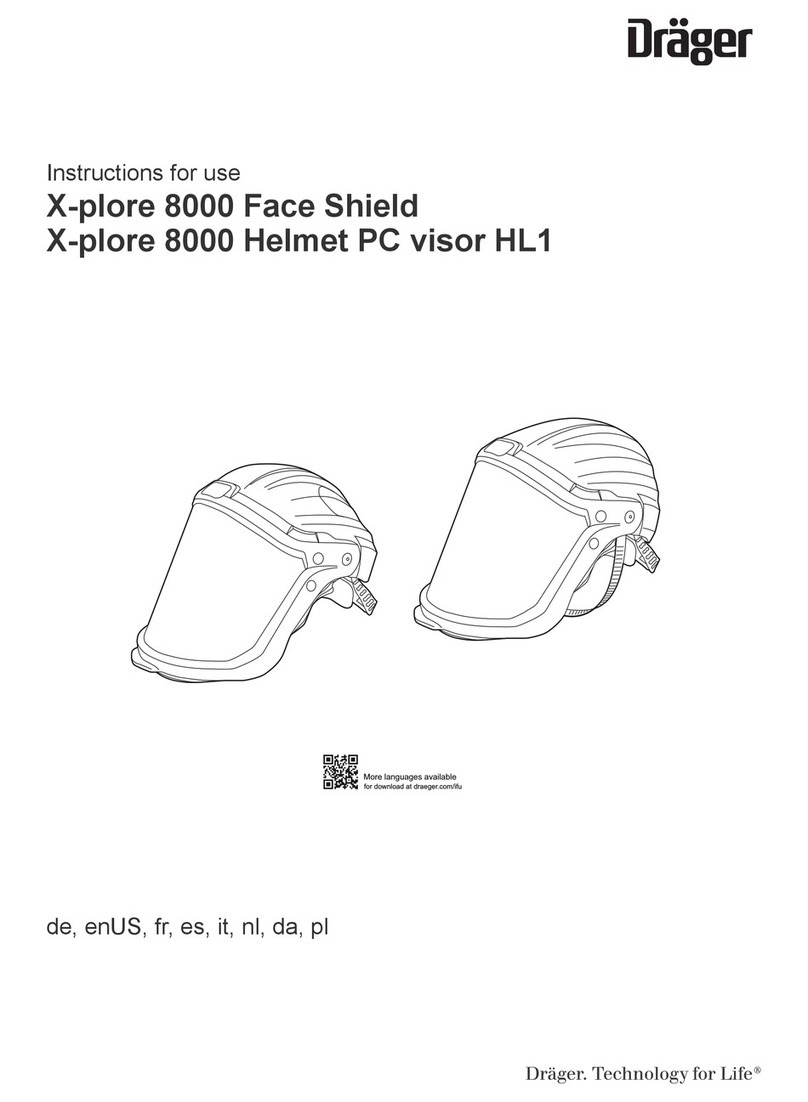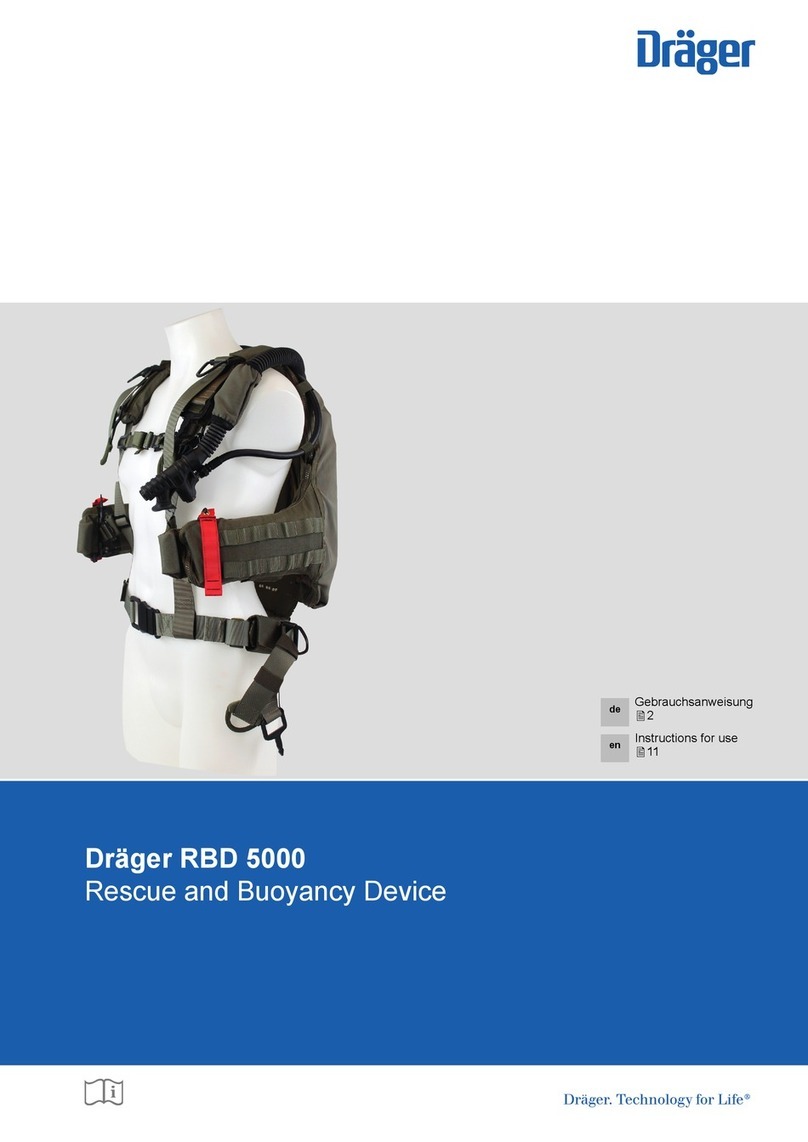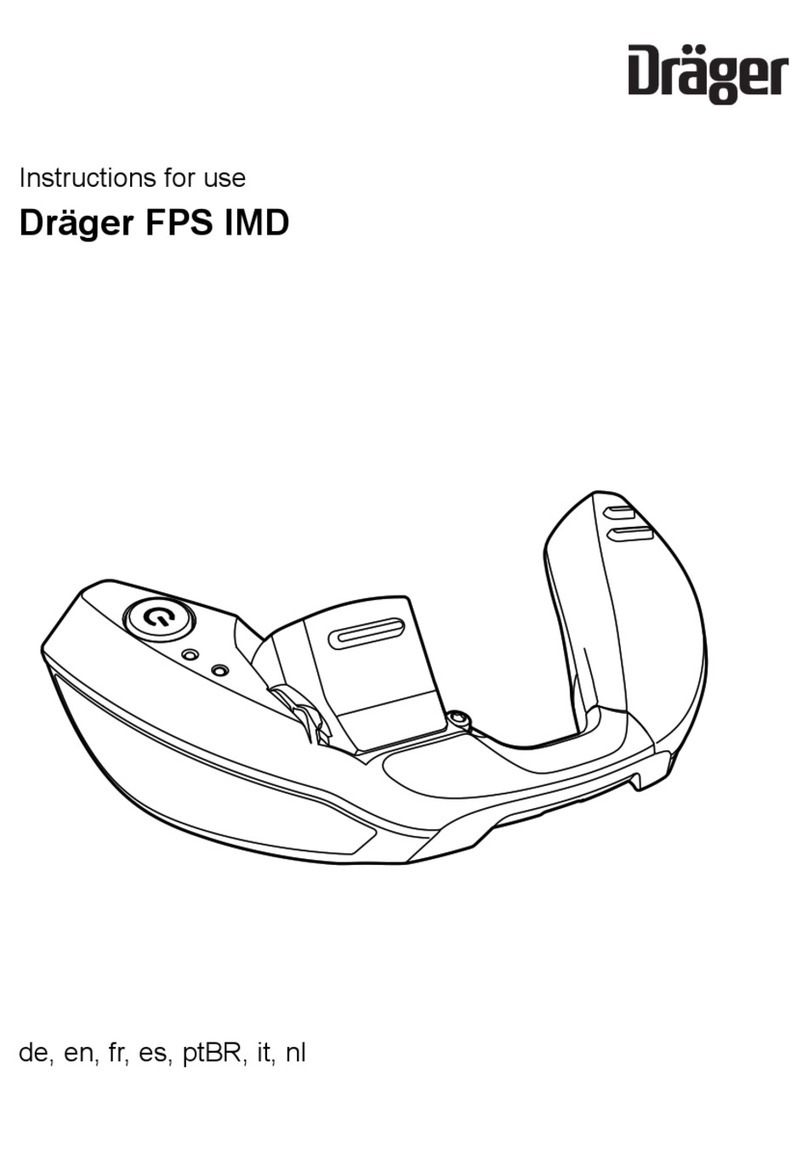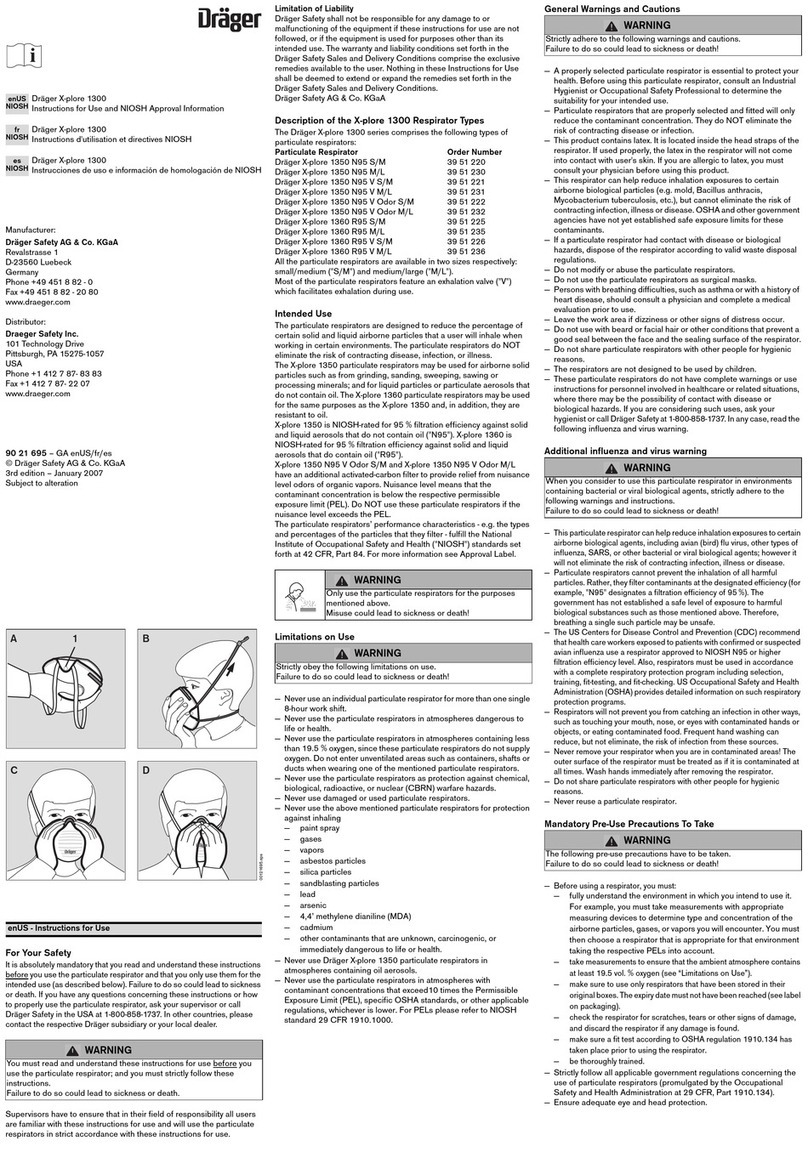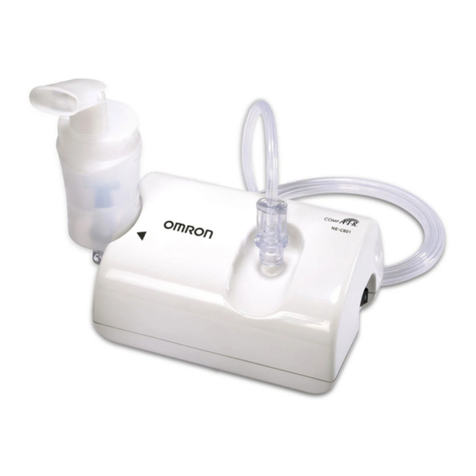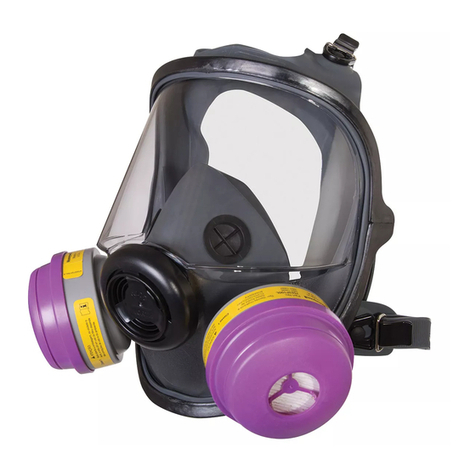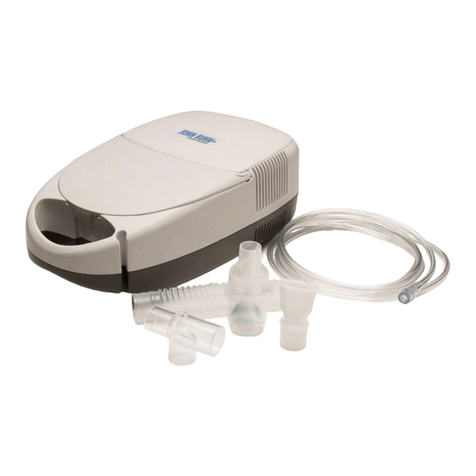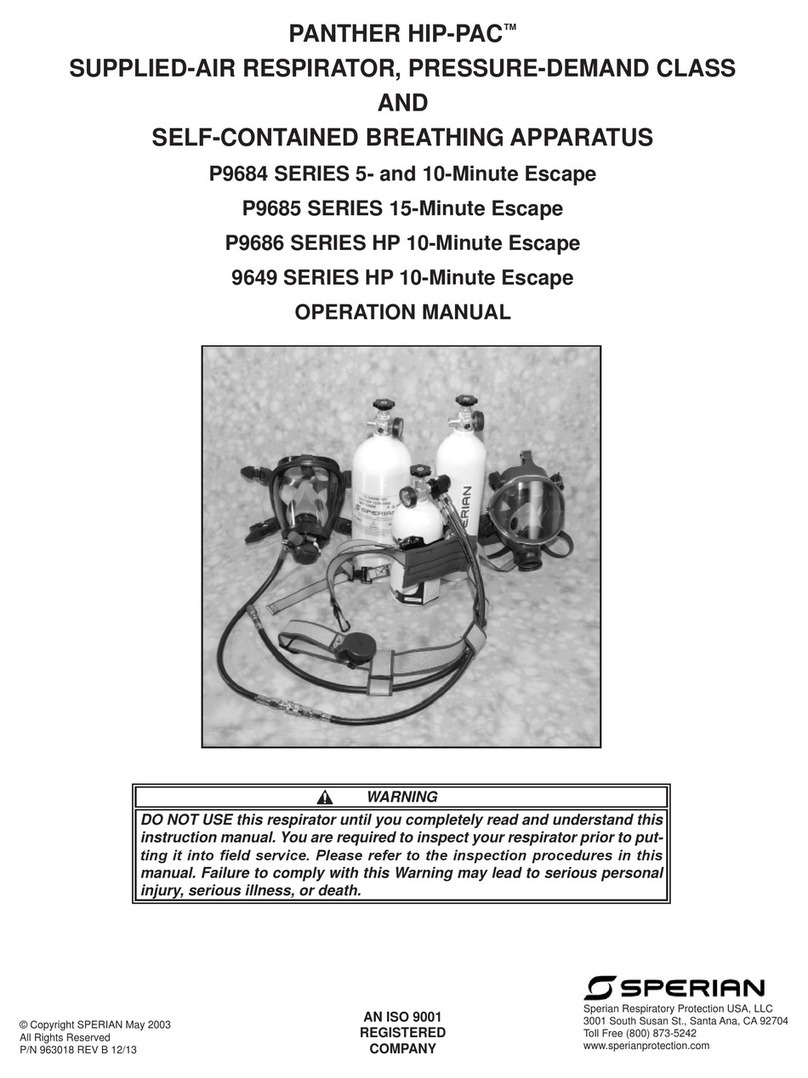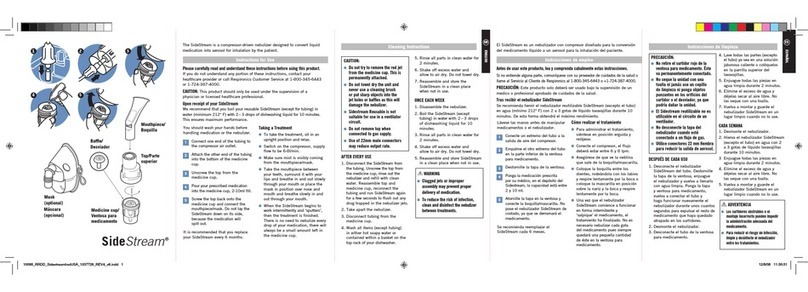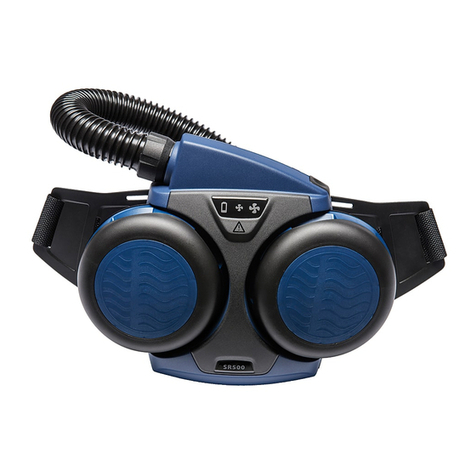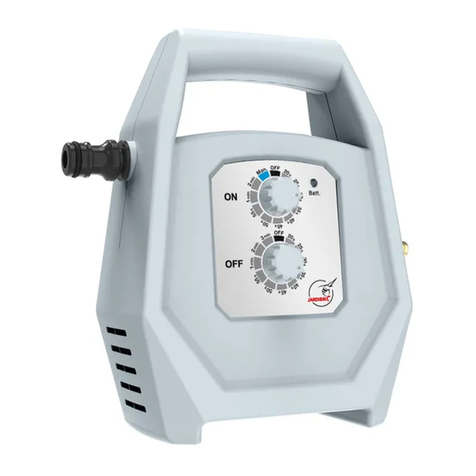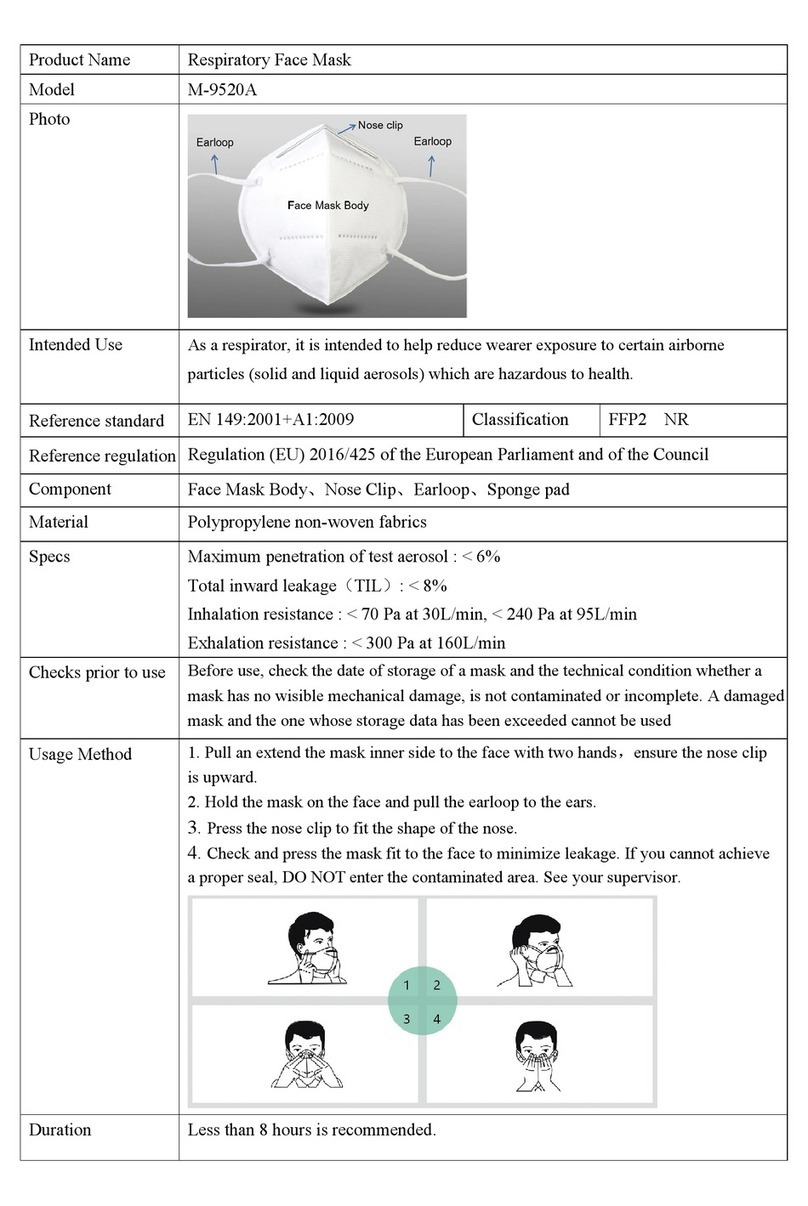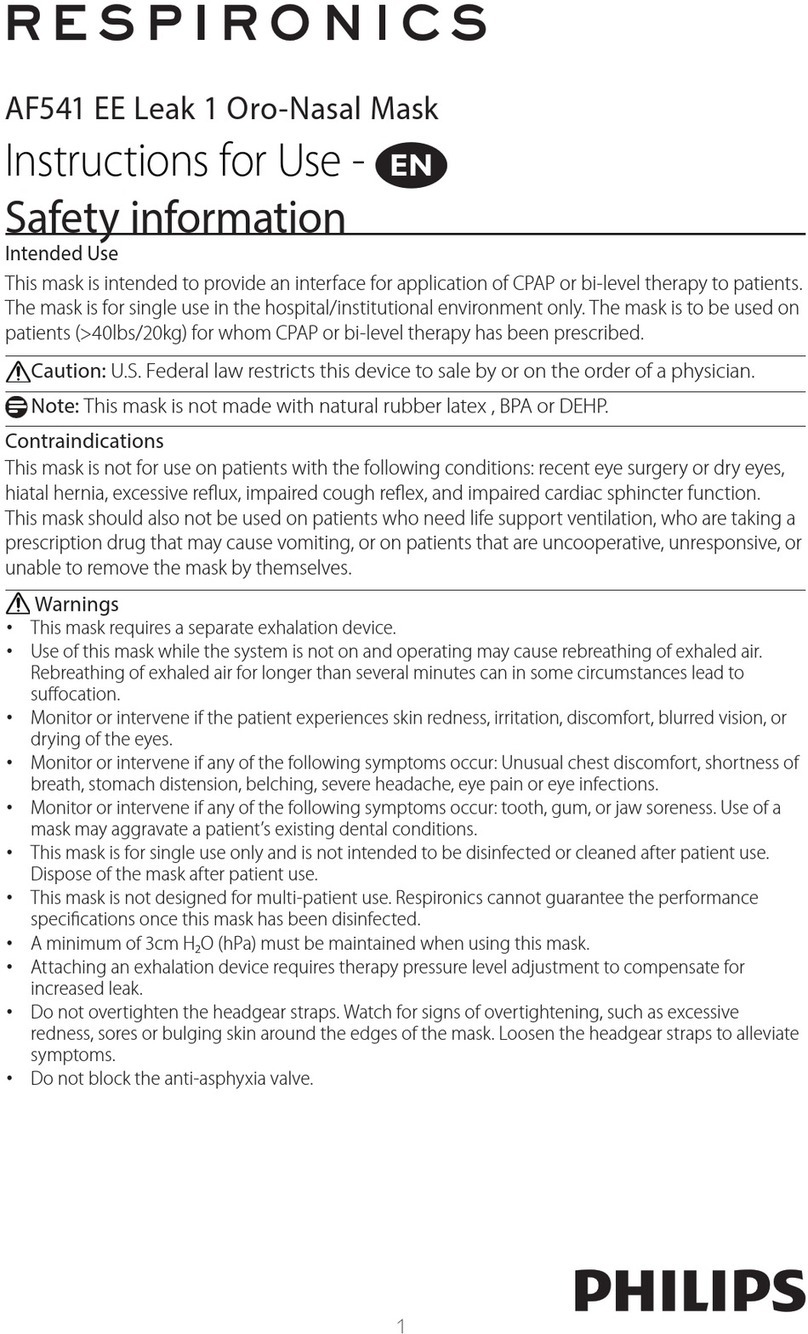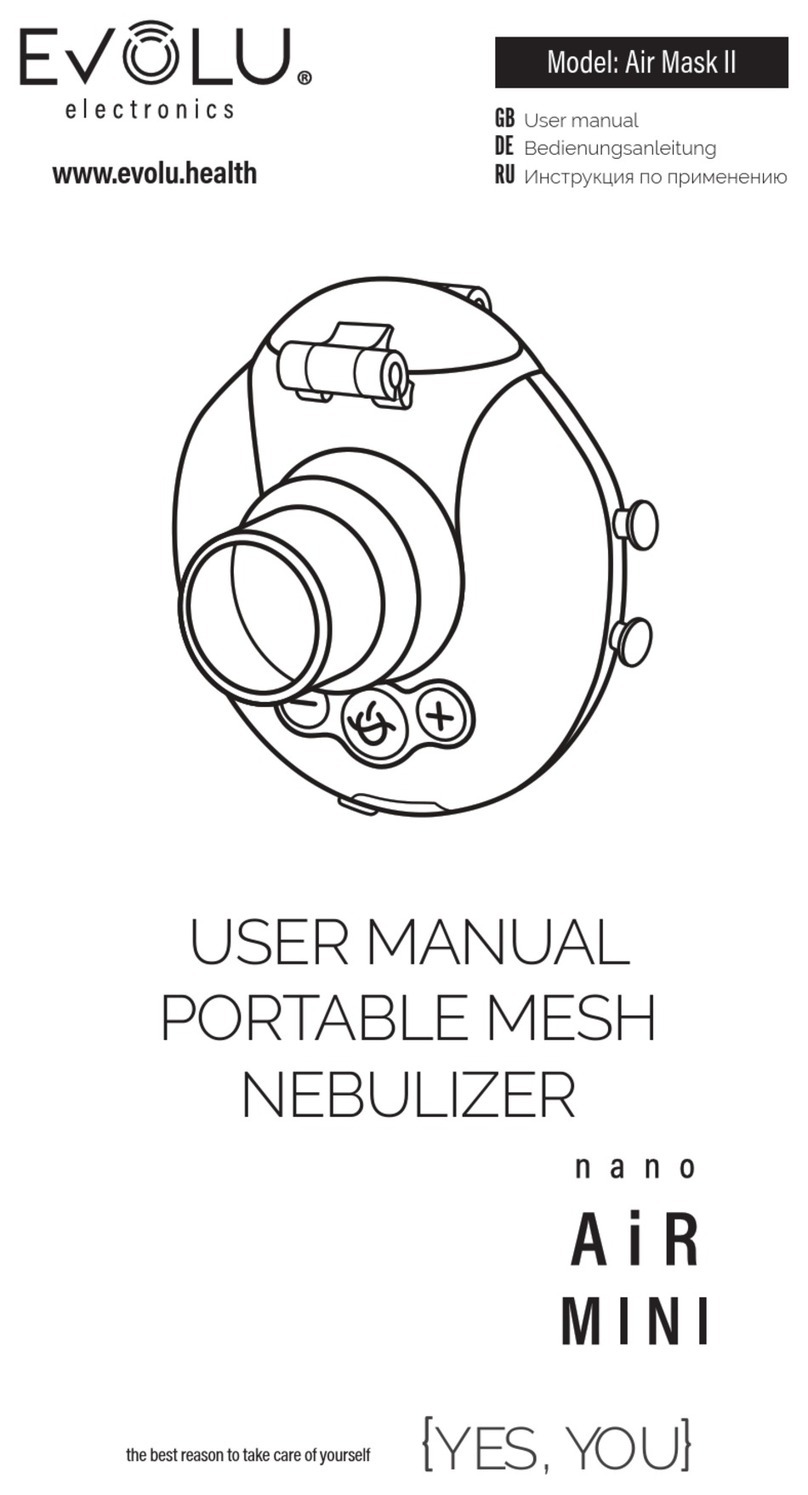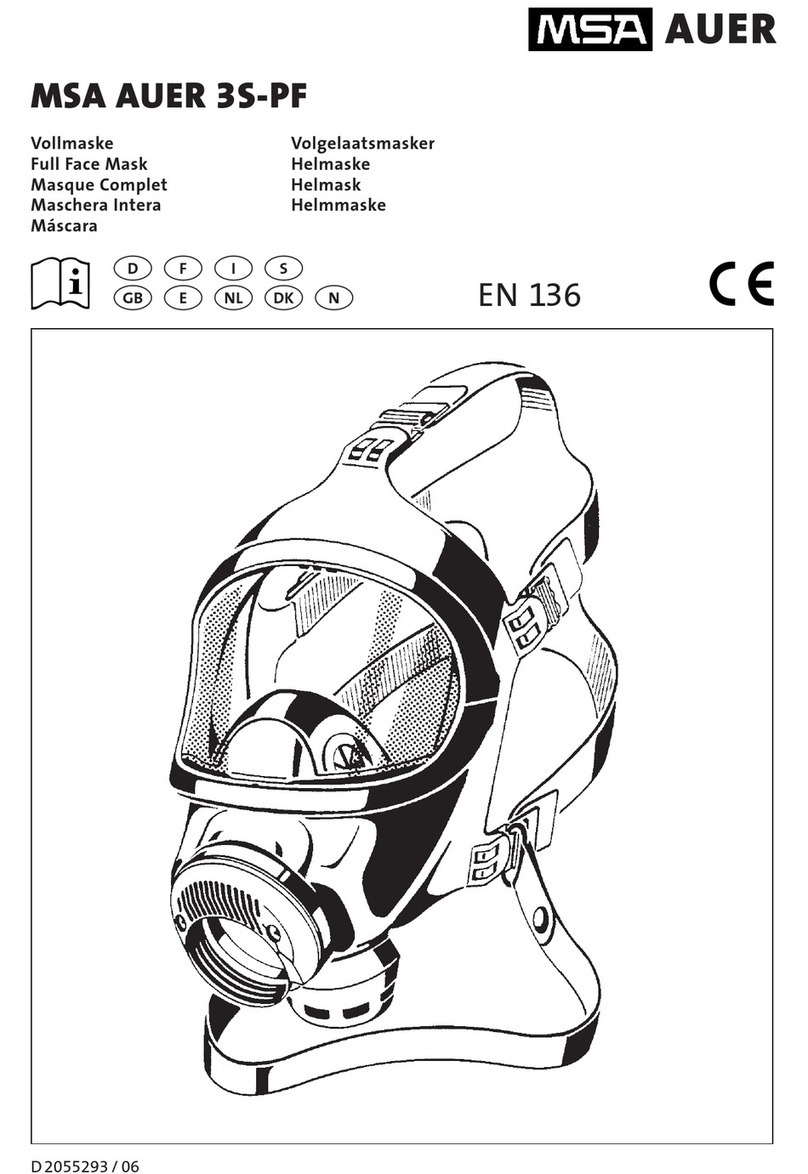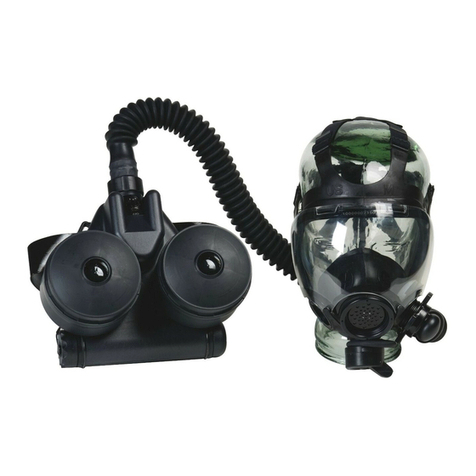Dow Corning®and Molykote®are registered trademarks of Dow Corning Corporation. 3362050 (A3-D-P) Page 2 of 2
3362050
© Dräger Safety UK Limited
Edition 04 – August 2018 (Edition 01 – January 2013)
Subject to alteration
Draeger Safety UK Limited
Ullswater Close Tel +44 1670 352 891
Blyth, NE24 4RG Fax +44 1670 356 266
United Kingdom www.draeger.com
the filling time and final pressure are dependent on the pressure
and volume of air in the cylinder and the charging air source.
○Due to rapid compression of cylinder air, a small temperature
increase occurs during refilling. The system will top up the cylinder
as it cools if it remains connected to the charging air source.
4. Keep the ChargAir system connected and breathe normally until a full
evacuation is possible.
5. When required, disconnect the quick coupling by pulling the sleeve of
the female coupling away from the male coupling (see the arrow in
Fig 7). As the coupling separates, a hiss or pop may be heard as the
shut-off valves in the couplings close. The duration of the cylinder air
begins from the time of disconnecting from the ChargAir connector.
6. Immediately proceed to a safe breathing environment (see
Section 3.3.1).
3.4 After use
After any use, the product must be checked and then returned to the ready-
for-use condition. The after use maintenance tasks (see Section 4.1.2)
must be carried out by Dräger or trained service personnel to prepare the
product for use.
4 Preparing and maintaining the
PAS Colt PPM
The tasks in this section must be carried out to prepare and maintain the
PAS Colt PPM in a ready-for-use condition.
4.1 Maintenance periods
4.1.1 Daily checks
It is essential that escape apparatus is ready for use at all times, and
Dräger therefore recommend a daily check. If the customer’s on-site risk
assessment concludes that less regular checks are acceptable, this can be
extended to a maximum of one month. It is the customer’s responsibility to
ensure that the equipment is ready for use at all times.
●Check that the pointer of the cylinder pressure gauge is inside the
green area. Charge the cylinder if it is in the red area (see Section
4.2.7).
●Ensure that the automatic activation device of the cylinder valve is
properly connected (Fig 2, Items 1 and 2).
4.1.2 Maintenance table
Dräger recommend that regular inspection, testing and servicing of the
breathing apparatus is carried out in accordance with the table below. The
table applies also to out-of-use (stored) equipment.
Additional inspection and testing may be required in the country of use to
ensure compliance with national regulations governing the use,
maintenance, examination and testing of this product.
Notes
Dräger recommendations
1. Clean the equipment if it is dirty. If it the equipment has been exposed
to contaminants, disinfect any components that come into direct and
prolonged contact with the skin.
2. These maintenance tasks may only be carried out by Dräger or trained
service personnel. Details of the tasks are contained in the technical
manual which is issued to service personnel that have attended a
relevant Dräger maintenance course.
3. As a guide, lubricant should be felt on the fingers but not seen. If
relubrication is required, lightly apply Dow Corning®Molykote®111
(other lubricants are not tested and may damage the equipment).
4.2 Maintenance tasks
4.2.1 Visual inspection
Carry out a visual inspection, checking the full breathing apparatus
including all component parts and accessories. Check that the equipment
is clean and undamaged, paying particular attention to pneumatic
components, hoses and connectors. Typical signs of damage that may
affect the operation of the breathing apparatus include impact, abrasion,
cutting, corrosion and discoloration. Report dirty or damaged equipment to
Dräger or trained service personnel, and do not use until faults are rectified
and the product is cleaned.
4.2.2 Removing the mask
Removing the mask in this way is only required for mask maintenance or
cleaning. The procedure to remove the mask during escape use is in
Section 3.3.
Component
/System
Task After
use
Every
month
Every
year
Every
10
years
Complete
equipment
Visual inspection (see
Note 1 and
Section 4.2.1)
Leak test (see
Section 4.2.8)
Functional tests (see
Note 2)
Lung
demand
valve O-ring
Check and lubricate if
necessary (see Note 3)
Pressure
reducer
Basic overhaul. Contact
Dräger for the Repair
Exchange (REX) service
Cylinder
valve
Basic overhaul. Contact
Dräger for the Repair
Exchange (REX) service
Cylinder Charge to correct
pressure (see
Section 4.2.7)
Cylinder pressure test
and recertification; and
check the test date on
the cylinder (composite
cylinders over 15 years
old must be retired)
Carry out in line with national
regulations
1. Pull open the flaps of the bag.
2. Disconnect the sprung-gate clip (Fig 2, Item 2) from the mask pull ring.
3. Pull the mask out of the bag.
4.2.3 Fitting the mask
1. Press the reset button (Fig 3, Item 2) to ensure that the lung demand
valve is switched off.
2. Pull the elasticated head harness of the face mask over the front of the
mask (see Fig 8).
3. Place the mask into the bag (Fig 9), ensuring that mask is fully inserted
as shown in Fig 10.
4. Connect the sprung-gate clip (Fig 2, Item 2) to the mask pull ring.
5. Close the flaps of the bag, ensuring the magnetic strips meet fully.
4.2.4 Removing the cylinder
WARNING
High-pressure air release may cause injury to the user or other
personnel near the breathing apparatus. Ensure that the locking
clip is fitted in the cylinder valve and fully vent the system before
attempting to disconnect the air cylinder.
When the cylinder valve outlet is open to atmosphere (not
connected to the pressure reducer or a charging adaptor), do not
remove the locking clip unless the cylinder is completely
discharged. Removing the locking clip would immediately exhaust
high-pressure cylinder air. To fully discharge the cylinder, see
Section 4.2.6.
1. Ensure that the locking clip (Fig 2, Item 1) is fitted in the cylinder valve,
and disconnect the sprung-gate clip (Fig 2, Item 2) from the mask pull
ring.
2. Press the front button (Fig 3, Item 3) to fully vent the system.
3. Disconnect the pressure reducer from the cylinder valve.
4. Carefully remove the cylinder from the holster. To prevent damage,
ensure that the handwheel of the pressure reducer remains clear of the
cylinder.
4.2.5 Fitting the cylinder
CAUTION
Fitting a cylinder that is charged above 200 bar could activate the
ChargAir pressure-relief valve and damage the valve seat. If the
ChargAir pressure-relief valve activates, the breathing apparatus
must be returned to the nearest Dräger branch or agent for
inspection and repair at the first opportunity.
1. Ensure that the cylinder is fully charged, with the pointer of the cylinder
pressure gauge inside the green area.
2. Check that the threads of the valve port and the pressure reducer
handwheel are undamaged, and the O-ring (Fig 11, Item 1) is in
position and undamaged.
3. Fully insert the cylinder into the carrying holster. To prevent damage,
ensure that the cylinder remains clear of the handwheel of the
pressure reducer while inserting the cylinder.
4. Align the cylinder with the pressure reducer and tighten the handwheel
(anticlockwise) hand tight (Fig 12).
5. Carry out the leak test (see Section 4.2.8).
6. Press the reset button (Fig 3, Item 2) to ensure that the lung demand
valve is switched off.
7. If not already fitted, fit the mask into the bag (see Section 4.2.3).
8. Connect the sprung-gate clip (Fig 2, Item 2) to the mask pull ring.
4.2.6 Fully discharging the air cylinder
1. Ensure that the pressure reducer is connected to the cylinder valve.
2. Remove the locking clip (Fig 2, Item 1) from the cylinder valve.
3. Press the front button (Fig 3, Item 3) of the lung demand valve and
allow the cylinder to fully vent. Do not direct the air toward the face,
eyes or skin.
4.2.7 Air cylinder charging
WARNING
Air quality for compressed-air cylinders shall meet the
requirements for breathing air according to EN 12021.
NOTICE
Do not use the ChargAir system for normal cylinder filling. The
ChargAir system is intended for emergency use only.
●The charging connector is a G5/8 connector as per EN 144-2:1999.
●Refer also to the instructions supplied with the cylinder and the
charging unit for recharging the cylinder.
●Only charge compressed-air cylinders which:
○Conform to national standards.
○Feature the original manufacturer’s test date and test mark.
○Have not exceeded the test date indicated on the cylinder by the
last testing station.
○Are not damaged.
●Dräger recommend a charge rate of 27 bar/minute (rapid charging will
increase the temperature resulting in an incomplete charge).
●To prevent over charging of the cylinder, Dräger recommend using a
pressure-limiting device on the charging compressor.
1. Remove the cylinder (see Section 4.2.4).
2. Connect the charging adaptor to the cylinder valve (Fig 13).
3. If the cylinder is still pressurized, approximately match the charging
line pressure to the cylinder pressure.
4. Remove the locking clip (Fig 2, Item 1) from the cylinder valve.
5. Recharge the cylinder to 200 bar (the pointer of the cylinder pressure
gauge inside the green area).
○Compression of cylinder air can cause a small temperature
increase during refilling, resulting in an incomplete charge. If
necessary, top up the cylinder when it cools.
6. When the cylinder is fully charged, refit the locking clip: press the
button down against the spring and insert the locking clip into the slot
(Fig 14), ensuring that the button remains in the locked (down)
position.
7. Vent pressure from the charging hose and then remove the charging
adaptor from the valve.
8. Refit the cylinder (see Section 4.2.5).
4.2.8 Leak test
WARNING
If breathing apparatus fails to meet any of the standards or
parameters described in the leak test, or if an immediate leak is
evident, there is a system fault. Report the fault to trained service
personnel or contact Dräger. Do not use the breathing apparatus
until the fault condition is rectified.
1. Ensure that the pointer of the cylinder pressure gauge is inside the
green area.
2. Press the reset button (Fig 3, Item 2) to ensure the lung demand valve
is switched off.
3. Remove the locking clip (Fig 2, Item 1) from the cylinder valve to
pressurize the system and then refit the locking clip: press the button
down against the spring and insert the locking clip into the slot (Fig 14),
ensuring that the button remains in the locked (down) position.
○There should be no audible leak. If there is any leak, investigate
and repair the leak before use. If necessary, use a soapy solution
to locate the leak.
4. Press the front button (Fig 3, Item 3). A small amount of air will vent
from the system.
5. Press the reset button (Fig 3, Item 2) to switch off the air flow through
the lung demand valve.
4.2.9 Disconnecting the lung demand valve
1. Press the release button and remove the lung demand valve from the
mask (Fig 15).
2. Remove the pull handle (Fig 15, Item 1) from the lung demand valve.
4.2.10 Connecting the lung demand valve
1. Place the pull handle on to the mask, and align the pull ring
(Fig 16, Item 1) on the front of the mask as shown.
2. Press the lung demand valve into the mask port.
3. Check the attachment by gently attempting to pull the coupling apart.
4.3 Cleaning and disinfecting
CAUTION
Do not exceed 60 °C for drying, and remove components from the
drying facility immediately when dry. Drying time in a heated dryer
must not exceed 30 minutes.
Do not immerse pneumatic components in cleaning solutions or
water.
If water is trapped and then freezes inside the pneumatic system
of the breathing apparatus (such as the lung demand valve),
operation will be impaired. Prevent any liquid from entering, and
thoroughly dry the breathing apparatus after cleaning to prevent
this from occurring.
Do not lubricate or allow oil, grease or other contaminants to
contact ChargAir fittings or hoses.
For information about suitable cleaning and disinfecting agents
and their specifications refer to document 9100081 on
www.draeger.com/IFU.
●Use only clean lint-free cloths.
1. Clean the breathing apparatus manually using a cloth moistened with
cleaning solution to remove excess dirt.
2. Apply disinfecting solution to all internal and external surfaces.
3. Rinse all components thoroughly with clean water to remove all
cleaning and disinfecting agents.
4. Dry all components using a dry cloth, in a heated dryer or in air.
5. Contact Dräger or trained service personnel if disassembly of
pneumatic components is required.
5 Troubleshooting
There is no user troubleshooting on the PAS Colt PPM. Contact Dräger or
trained service personnel to report any issues with the product.
6 Storage
Dräger recommend that the PAS Colt PPM is stored in a cool dry
environment, in a location where it is not subject to wear or damage due to
abrasion. Note also the following:
●Extend the shoulder strap and the waist belt.
●Route rubber hoses in such a way that the bend radius is not too acute
and the hose is not stretched, compressed or twisted.
●Fix the apparatus securely to any raised mounting point to prevent it
from falling.
7 Disposal
When required, dispose of the PAS Colt PPM in accordance with national
or local regulations for waste disposal.
8 Order list
Description Quantity Order code
Dow Corning®Molykote®111 100 grams 3331247








